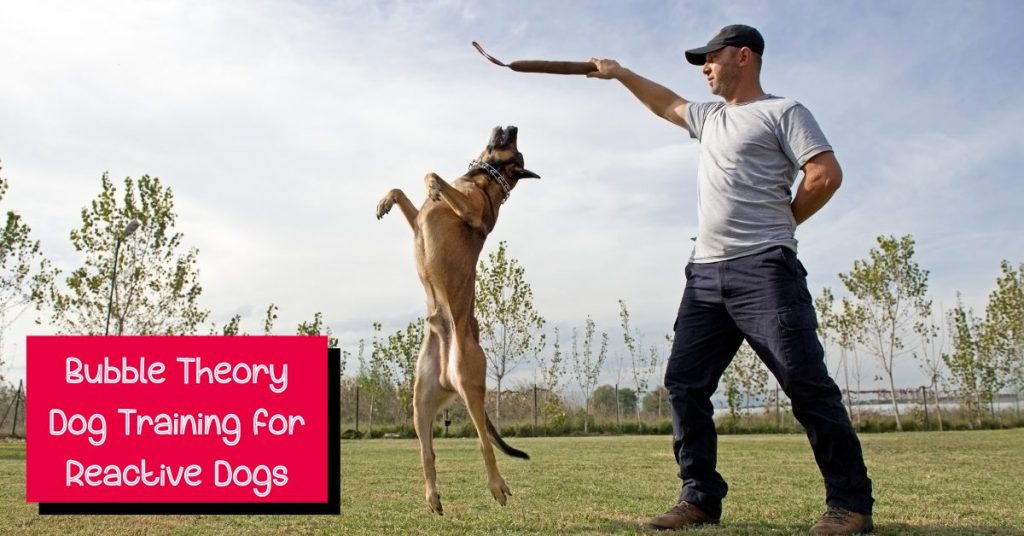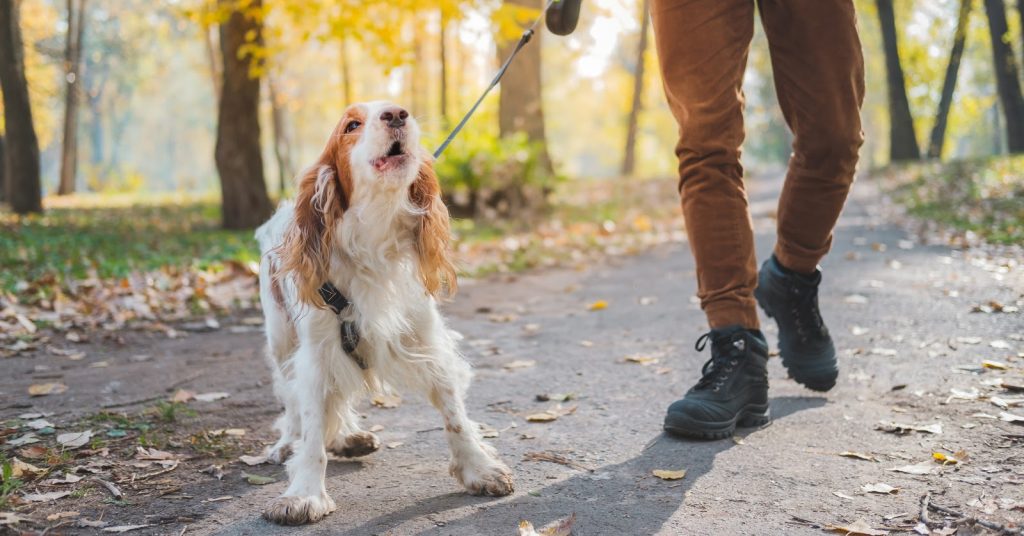What is bubble theory dog training for reactive dogs? It’s a topic that has recently been picking up steam within the dog owner community. As a result, I decided to dive deeply into everything about it to see if it’s a viable technique. So read on, and you’ll soon know everything needed to determine if it’s right for your pup.

Everything to Know About Bubble Theory Dog Training for Reactive Dogs
The following sections will look at bubble theory dog training from every angle. It’ll also help you understand more about what is considered reactive. From there, a picture will form about how/whether this method could help these dogs during their training.
What is Bubble Theory Dog Training?
Bubble theory dog training isn’t a method that’s been around long. In fact, this approach has become more of a recent phenomenon within the dog owner community. But its newness doesn’t mean the technique doesn’t have merit.
It stems from a line of thinking that dogs are best suited to learn in a relaxed environment. Sadly, this relaxed setting won’t include actual bubbles. This realization was quite devastating to me when first researching the top.
But anyway, bubble theory relies on creating a “bubble” around your dog during training. It’s similar to what most people call a safe space. Inside this zone, dogs will become much more capable of retaining whatever you’re training them to do.
Of course, every dog inherently has their own safe space. So this theory plays on an owner getting inside the area to encourage a more friendly training experience. It’s why people have utilized this method to work with reactive dogs (more on them later).
Reactive dogs will have a much larger personal space bubble than other dogs. It’s their barrier to keep away all the things that make them scared or anxious. In comparison, confident dogs will have a much smaller one.

Benefits of Bubble Theory Training
Bubble theory training wouldn’t be worth the time if it didn’t provide some benefits. So let’s not waste any time and look into why people are starting to value this training method:
- Creates a relaxing training environment: Stress and anxiety are the main enemies of a dog retaining what’s being taught during training. Bubble theory can limit their effect on your dog by cultivating a calm and safe space.
- Obtains your dog’s focus: Placing your dog inside their space bubble helps stop outside elements from distracting them. In a way, you’re putting blinders up to ensure they remain focused on the lesson.
- Deepens the owner/dog bond: The lack of distractions encourages more focus on the owners, which helps develop a stronger bond.
What Is a Reactive Dog?
So understanding bubble theory is only one part of this equation. The other side is coming to grips with what experts mean when they call a dog “reactive.” Basically, this term refers to when a dog becomes overly responsive to an ordinarily occurring event.
For instance, a dog barking at someone knocking at the door isn’t reactive. But a dog becoming overly aggressive with continuous barking at the sight of another canine would be considered reactive.
In simplest terms, it’s when a dog reacts abnormally/overreacts to a stimulating event. These incidents are when canines get labeled as reactive dogs.
How to Use Bubble Theory Dog Training to Help a Reactive Dog
Using bubble theory dog training for reactive dogs isn’t too tricky. In fact, the entire process only requires the following five steps to help curb those reactionary tendencies.
Step 1: Shrinking Your Dog’s Bubble
The first step is getting your dog comfortable with you in their space. In other words, this part is about establishing them being okay with you within about 2 feet of them. But avoiding jumping right into the deep end with a reactive dog is vital.
So don’t just run right up to their face and stand there. It’ll only cause an adverse reaction from them, which defeats the entire purpose of this training. So instead, this step needs to be done at a slow and steady pace.
At first, some reactive dogs won’t handle your presence too well. It’s a common occurrence with canines who have experienced trauma, such as rescue dogs. In these cases, owners should get as close as possible while keeping their dogs comfortable.
The bubble will eventually start shrinking with some time and patience. You can then start moving closer without your dog becoming reactive.

Step 2: Use the Bubble Space to Train
After establishing comfort inside the 2-to-3-foot bubble, the training can start. You’ll want to enter the space, get close to your dog’s face, and make eye contact with them. Your dog will attempt to swing their head away from your gaze.
However, getting them to make eye contact with you is critical. This process will mold a connection and power dynamic between you two.
You’ll also want to grab some treats and reward your dog whenever eye contact is established. This technique uses positive reinforcement to encourage eye contact as good behavior. Once it’s installed, teaching them commands becomes a lot easier.
Step 3: Make Your Dog’s Bubble Larger
If your dog has become comfortable with the small bubble training, it’s time to expand. This step will widen their comfort zone to stop those reactive events. You’ll want to maintain solid eye contact while increasing the distance inside this bubble. But again, you should do it slowly to avoid regressions from your dog.
The distance created will become vital when teaching complex commands and behaviors. Plus, your dog must learn how to thrive inside and outside their established comfort zones. So increasing the bubble’s distance will help cultivate that comfort.
Meanwhile, I’d start to include other dogs and people in your pup’s personal space. But incorporate them slowly and be mindful of your dog’s comfort level. Of course, you’ll also need to ensure these new additions don’t overly invade the space.
Step 4: Be Mindful of Your Dog’s Limitations
Humans often need to realize that dog training can only go so far. Some dogs will still react to other animals even if you spend years training. So it’s essential to realize your dog’s limitations at a certain point during these sessions.
Overall, the essential part of this process is knowing how to calm down your dog. You can then make sure those reactive episodes occur without any incidents. Everything else taught with bubble theory dog training is gravy if you learn that.
Step 5: Enjoy the Bond Created By This Process
This last step is simply enjoying the newly found bond with your dog. Training sessions with my dogs are some of my most rewarding experiences. I imagine you’ll feel the same when utilizing this bubble theory dog training method.
Lastly, check out this video if you’re looking for a visual aid for bubble training. It’ll walk you through the entire process without much difficulty.
In Closing,
Bubble theory dog training is an effective method of making a reactive dog more comfortable. During these training sessions, it’ll also cultivate a unique bond between owners and their dogs. So if you feel like it’d be rewarding to try, there’s no reason not to give it a shot.
Remember to leave us any questions or concerns in the comment section. I’ll always be available to help a fellow dog owner whenever needed. Thanks for reading!
Have you tried Bubble Theory dog training? Share your experiences below!

